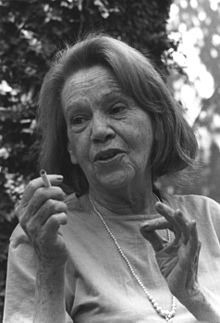|
Elena Garro
Elena Garro (December 11, 1916 – August 22, 1998) was a Mexican author, playwright, screenwriter, journalist, short story writer, and novelist. She has been described as one of the pioneers and an early leading figure of the Magical Realism movement, though she rejected this affiliation.[1] Alongside the works of Juan Rulfo, her first three books: Un hogar sólido (1958), Los Recuerdos del Porvenir (1963), and La Semana de Colores (1964), are considered to be among the earliest examples of Magical Realism in Latin American literature.[2] Garro's writing, despite being mostly fictional prose, borrowed heavily from poetry and its literary elements. Author and biographer Patricia Rosas Lopategui has described Garro's style as "an attempt to rescue the use of everyday language in the form of poetry".[3] Her style has also been compared to that of French writers like Georges Schéhadé, Jean Genet, as well as Romanian-French playwright Eugène Ionesco, due to the surreal nature of her stories. A close friend of Albert Camus, her works were also heavily influenced by his style and philosophy.[3] She was the recipient of the Sor Juana Inés de la Cruz Prize in 1996. Her tumultuos marriage with writer Octavio Paz, winner of the 1990 Nobel Prize in Literature, has been the subject of much scrutiny. Garro herself would describe the relationship as "filled with forbiddance, resentments, and rancour for not making each other happy".[4] Despite the hostilities, they are considered among the most talented couple of writers to emerge during the Latin American literary boom of the twentieth century. Garro is seen as one of the unsung figures of the boom; her legacy was influenced, in part, by her rejection of Magical Realism as she considered the term "a cheap marketing label".[2] Contemporary historians and literary biographers consider her work as seminal and view her as having been as important as figures like Juan Rulfo, Gabriel García Márquez, Julio Cortazar, and others.[5] BiographyEarly life and educationElena Garro was born in Puebla, Mexico to José Antonio Garro Melendreras, a Spanish national and Esperanza Navarro Benítez, a native from Mexico's northern state of Chihuahua. The third of five children, she spent her childhood in Mexico City but moved to Iguala, Guerrero, during the Cristero War. At the age of 12 she returned to Mexico City where she would finish her studies at the Antiguo Colegio de San Ildefonso.[6] Afterwards, she would study literature, choreography and theater in the National Autonomous University of Mexico in Mexico City, where she was an active member of Julio Bracho's theatre group.[6] During her time at the National Autonomous University of Mexico she would meet Octavio Paz with whom she would start a relationship. They would get married in 1937.[7] At the age of 21, during their first year of marriage, Garro would travel to Spain alongside her husband to attend the second edition of the International Congress of Writers in Defense of Culture. Among the attendees where other Latin American writers and poets like Pablo Neruda and Alejo Carpentier, American poet Langston Hughes, and other Mexican cultural figures of the time like Carlos Pellicer and Silvestre Revueltas.[8] Spain was in the midst of its Civil War and political fervors were in an all-time high. The congress was seen as an attempt from communists to spread their ideals and foster propaganda and that edition would be its last. Garro's would record her experiences during the trip and later on publish them as Memorias de España 1937, published in 1992.[8] Bibliography
References
External linksWikiquote has quotations related to Elena Garro. |
||||||||||||||
